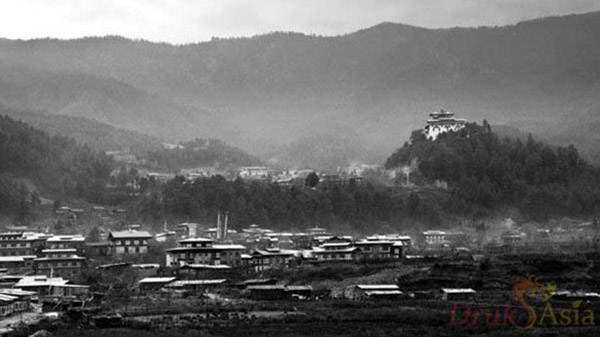Festival Date: 15th-17th November 2016
Attend the highly intimate Prakhar Tsechu with Druk Asia, a Bhutan tour operator. This is a highly popular festival that require booking months in advance.
Itinerary
Day 1: Arrival in Paro, Bhutan
Welcome to Bhutan, the Land of the Thunder Dragon. Touching down at Paro International Airport, you will be greeted by your guide upon exiting the arrival hall. Today, we will take it easy to acclimatise to the altitude. Drive to Thimphu, check in to the hotel and let’s have your first taste of Bhutanese cuisine and some light sightseeing in Thimphu if possible.
Buddha Point at Kuensel Phodrang, will be open to tourists once it is completed in 2012. The 169 feet bronze statue of Buddha Dordenma , Vajra Throne Buddha symbolising indestructibility will be completed soon. The Buddha statue itself is competed awaiting paintings, but visitors can drive up to the Buddha point and view the tallest statue of Lord Buddha. The view of Thimphu valley from the Buddha point is spectacular and beautiful, especially at night.
National Memorial Chorten – Which was built in honor of the late King Jigme Dorji Wangchuk.
Thimphu Dzong – The largest Dzong, is also the seat of the office of the King of Bhutan.
Hotels:
 Jumolhari Hotel |
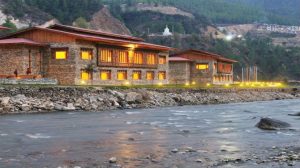 Terma Linca Resort |
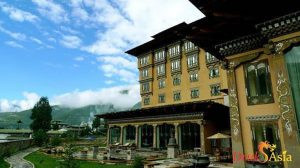 Taj Tashi Thimphu |
Day 2: Thimphu to Punakha
Dochula Pass – The 108 chortens was built by the present Queen Mother of Bhutan Ashi Dorji Wangmo Wangchuck to commemorate Bhutan’s victory over Indian militants and to liberate of the souls lost.
Punakha Dzong – Built in 1637, the dzong continues to be the winter home for the clergy, headed by the Chief Abbott, the Je Khenpo. It is a stunning example of Bhutanese architecture, sitting at the fork of two rivers, portraying the image of a medieval city from a distance. The dzong was destroyed by fire and glacial floods over the years but has been carefully restored and is, today, a fine example of Bhutanese craftsmanship.
Hotels:
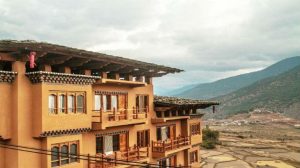 Hotel Lobesa |
 Meri Puensum |
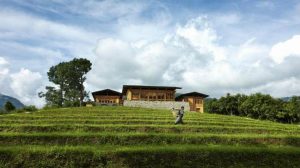 Uma Punakha |
Day 3: Punakha to Bumthang
We will start our 7 hour drive to Central Bhutan. Before we start we will pay a visit to Chhimi Lhakhang (left) – A 20 minutes walk across terraced fields through the village of Sopsokha from the roadside to the small temple located on a hillock in the centre of the valley below Metshina. Ngawang Chogyel built the temple in 15th century after the ’Divine Madman’ Drukpa Kuenlay built a small chorten there. It is a pilgrim site for barren women.
Hotels:
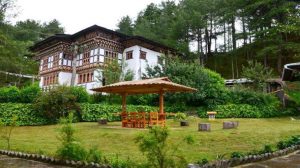 Rinchen Ling Resort |
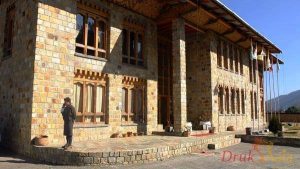 Wangdichholing Resort |
 Peling Hotel |
Day 4: Bumthang
This is one of the most spectacular valleys in Bhutan and also the heartland of Buddhism in Bhutan. It is an area with a wide variety of fauna and flora. The Guru Rinpoche and his lineage of Tertons (treasure finders) making Bumthang his home have led to more than 40 temples being built in this peaceful valley. Witness the tsechu today, a rich form of the oral history tradition where the Bhutanese pass on values, mythology and spiritual beliefs through the dance dramas.
Hotels:
 Rinchen Ling Resort |
 Wangdichholing Resort |
 Peling Hotel |
Day 5: Bumthang to Trongsa
The Prakhar Tshechu will culminate with a rare display of a giant silk applique thangkha (painting) depicting Guru Padmasambava or some other important Buddhist deity this morning. On route to Gangtey is Trongsa, the ancestral home of the ruling dynasty.
Trongsa, literally “New Town” in the Dzongkha language, is where the current monarchy had its origin in Bhutan. Each King in the line of succession has held the post of Trongsa Penlop or Governor before donning the Raven Crown.
Trongsa DzongThe foundations of Trongsa Dzong were laid in the 16th century by. Its foundation was laid by Pema Lingpa and flourished during the 17th century under Shabdrung Ngwang Namgyal. The impressive fortress is a massive structure, its wall looming high above the winding Mangde Chu Valley,commanding the east-west road.
The Trongsa Museum (Ta Dzong), sits high above the valley at a strategic vantage point over Trongsa Dzong. The “Tower of Trongsa” tells the stories of the dzong and the valley that it has watched over for centuries. His Majesty the King inaugurates the Ta Dzong as a museum dedicated to the Wangchuk dynasty, land marking yet another significant event as the nation celebrates 100 years of the monarchy. It has been restored into a classy museum that represents a tasteful blend of tradition and modernity. There are 224 items on display, include a sacred image of Sung Joenma Dorji Chang (self spoken Vajradharna), a bronze statue of Pema Lingpa, made by himself and a number of centuries old treasures like dance and ritual costumes and objects, ancient prayer books, paintings and scrolls and textiles.
Hotels:
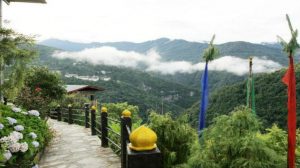 Yangkhil Resort |
 Wangdichholing Resort |
 Peling Hotel |
Day 6: Trongsa to Gangtey
The valley of Phobjikha is well known as the winter home of the Black necked crane (Grus Nigricollis). Bhutan is home to around six hundred black-necked cranes with Phobjikha being one of the popular places that the birds migrate to in the winter months from the Tibetan plateau. The elegant and shy birds can be observed from early November to end of March. This is an old monastery that dates back to 17th century.
Hotels:
 Homestay |
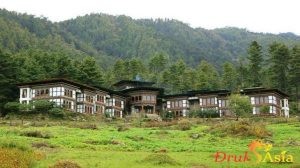 Dewachen |
Day 7: Gangtey
Nature Hike along the valley of Phobjikha – A short trek of about 90 minutes known as the ‘Gangte Nature Trail’ starts from the Mani stone wall to the north of the Gangteng Gonpa and ends in Khewa Lhakhang.
Hotels:
 Homestay |
 Dewachen |
Day 8: Gangtey to Thimphu
Thimphu, the modern capital of Bhutan. Made up of just three main streets, it is only one of 2 capitals in the world without traffic lights. As the capital of Bhutan, Thimphu offers a rich cultural heritage with places of interest as listed below.
In the morning, we will head to Thimphu, driving pass Wangdue and Dochula Pass again.
Once we reach Thimphu, perhaps its time for you to take a short break. Seat yourself at one of the numerous cafe in town and write postcards for your family and friends. Or head to a view point to visit the Takin Enclosure or view Thimphu from afar.
Hotels:
 Jumolhari Hotel |
 Terma Linca Resort |
 Taj Tashi Thimphu |
Day 9: Tour of Thimphu
Heritage Museum – Dedicated to connecting people to the Bhutanese rural past though exhibition of artefacts used in rural households.
Textile Museum – Witnesses the art of traditional weaving.
Paper making Factory – Witnesses the art of papermaking
Takin enclosure – On the way to the viewpoint over Thimphu is the home of Bhutan’s national animal, the Takin; a strange looking beast some say looks like a bee stung moose.
Centenary Farmers’ Market – Every Saturday and Sunday most of the Thimphu population congregate on the banks of the river where the weekend market is held. Here villagers from the valley and other nearby places come to sell their agriculture products.
Hotels:
 Jumolhari Hotel |
 Terma Linca Resort |
 Taj Tashi Thimphu |
Day 10: Thimphu to Paro
Paro Valley – The beautiful valley is home to many of Bhutan’s old monasteries and temples. The country’s only Airport is in Paro. The valley is also home to mount Chomolhari (7,300 meters) situated at the northern end of the valley whose glacier water forms the Pachu flowing through the valley. The following are some of the prominent places to visit in Paro.
Paro Dzong – also known as Rinpung Dzong, this 15th century massive fortress/monastery, is also the administrative centre of the dzonkhag.
Ta Dzong – Built as a watch tower the Ta Dzong, it was converted into the National Museum in 1968. The museum boasts antique Thangka, textiles, weapons and armour, household objects and rich assortment of natural and historic artefacts.
Hotels:
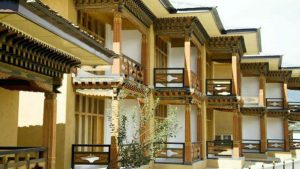 Tenzinling Resort |
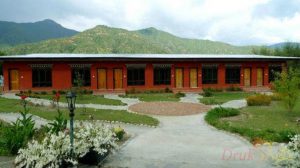 Metta Resort & Spa |
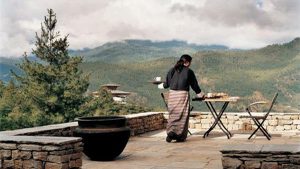 Uma Paro |
Day 11: Paro
A morning drive, north of Paro valley brings us to the ruins of Drukgyal Dzong. Built in 1647 by the great Shabdrung Ngawang Namgyal, father and unifier of medieval Bhutan, the Dzong was destroyed by an accidental fire and left in ruins as an evocative reminder of the great victories it was built to commemorate. Explore the ramparts and relive the memories of a glorious past.
Beyond Satsam Chorten, we hike up to the Taktsang Monastery (Tiger’s nest). The 1.5 hour hike to the cafeteria is also a vantage view whereby you can enjoy the stunning view of the monastery. Prayer flags adorn the clifts and this is also where Guru Padmasambhava landed on the back of a tigress in the 8th century. After a sumptuous local lunch, we will retrace our steps to visit Kyichu Lhakhang, one of the oldest temples in Bhutan.
Hotels:
 Tenzinling Resort |
 Metta Resort & Spa |
 Uma Paro |
Day 12: Depart Paro
Today we will bid fond farewell to this beautiful Himalayan country and take an early flight back to Singapore. We hope by now you would have made some friends and also kept many photos and beautiful memories of Bhutan! And we look forward to seeing you again in this beautiful land of endless Enchantments! Tashi Delek!
What’s Included
» Private guided tour
» Visas for Bhutan
» Airport transfers
» Daily 3 meals (B/L/D) at designated restaurants or hotels
» Accommodation at 3 star hotel
» A qualified & licensed English-speaking guide
» An experienced driver
» A tour vehicle
» Entry fees & road permits
» Government fee, royalty, taxes & surcharges
» Mineral bottled water
» Set of traditional costume (to be return at the end of your stay)
» Full service & assistance before, during and after your Bhutan trip
Suitable Months
Festival Date: 15th-17th November 2016
Prices
For Travel during Prakhar Tsechu
USD 3,239 for 1 person traveler
USD 3,129 per person for 2 person travelers
USD 2,799 per person for group with 3 or more
What’s Excluded
» Flight into Bhutan via Drukair (can be arranged with us)
» Flight on other airline to catch Drukair Flight
» Hotel stay outside of Bhutan
» Travel Insurance (can be arranged with us)
» Meals at 4-5 stars restaurants
» Tips for the guide and driver
» Alcoholic drink
» Expenditure of personal nature
Our Guarantee
Guaranteed Visa approval. We have yet to disappoint a single of our travellers in term of Visa issuance.
Your choice of hotels will be confirmed for your inspection before your arrival. We only book you on hotels which we love and would love again.
We will be happy to change your guide, driver or vehicle on the first two days of arrival in Thimphu if you are not satisfied with our selection. Drop us a note and our hospitality team be on the spot to assist you.
We’re here to help. Our world-class member services team is available by phone or email — there’s no automated system or call center; you’ll communicate with a real person.

